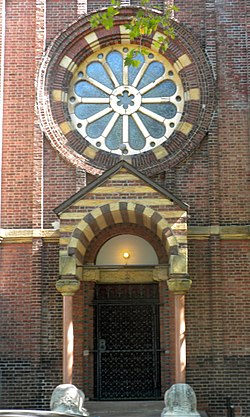Samuel S. Fleisher Art Memorial
|
Fleisher, Samuel S., Art Memorial
|
|
 |
|
| Location | 711-721 Catharine St., Philadelphia, Pennsylvania |
|---|---|
| Coordinates | 39°56′20″N 75°9′20″W / 39.93889°N 75.15556°WCoordinates: 39°56′20″N 75°9′20″W / 39.93889°N 75.15556°W |
| Area | 0.3 acres (0.12 ha) |
| Built | 1857 |
| Architectural style | Italianate, Romanesque |
| NRHP reference # | 82001547 |
| Significant dates | |
| Added to NRHP | November 14, 1982 |
| Designated PHMC | September 13, 2005 |
Samuel S. Fleisher Art Memorial, also known as Church of the Evangelists and St. Martin's College for Indigent Boys, is a set of four buildings with a history that unites idealism or religious beliefs, service to the poor, and art. Formerly an Episcopal church in the working-class Bella Vista neighborhood of South Philadelphia, it is best known as the home of the Graphic Sketch Club founded by Samuel S. Fleisher, which offers free art lessons to children and adults.
The four buildings include a campanile built in 1857, a basilica built 1884-1886, St. Martin's College built in 1906, and two rowhouses built in the 1850s. Since Fleisher's death in 1944, his trust, which owns the buildings, has been administered by the Philadelphia Museum of Art. The Art Memorial was listed on the National Register of Historic Places in 1982 and is located at 711-721 Catharine St. in Philadelphia, Pennsylvania.
The Church of the Evangelists was established as a mission church for the poor of Catherine Street in 1837, by Episcopalians named William Welsh and Horace Binney, among others. A church building was constructed in 1857 which includes the campanile which still stands. The church's viability became a concern by 1880, possibly because of the influx of non-Episcopal immigrants to the neighborhood.
Henry Robert Percival, a well-known high church Episcopal priest, revived the fortunes of the Church of the Evangelists when he was appointed rector about 1880.
The well-connected Percival had traveled in Italy and had "a sensibility which combined Italian and Anglo-Catholic romanticisms." He wished to rebuild the church based on the Romanesque models of St. Mark's Basilica in Venice, the Cathedral of Pisa and the Orvieto Cathedral. The 1884 design by the firm Furness and Evans was in actuality based on San Zeno Maggiore in Verona.
...
Wikipedia



